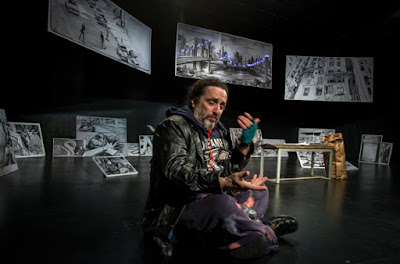Robert Galinksy’s play Bench is now playing at East Village Playhouse. Jay O. Sanders directs this one-man show which brings together the voices of several unforgettable characters who are homeless or living on the edge in a city, circa 1987. Among the problems these diverse folks face is the Human Immunodeficiency Virus (especially perilous for intravenous drug users) and general fear from the overprotective masses. One is exception is Pope John Paul II, who recently hugged an infected person to show that he did not believe rumors that the virus could be spread through a sneeze or a handshake. Our narrator gives us a rundown of 1980s contemporary society before taking on the stories of several people he himself spoke with back in the day. The performance takes place in a new gallery on 6th Street, which is decorated with Daphne’s Arthur’s urban drawings (which will be part of the upcoming graphic novel version of the same story).
“Graveyard” is a Vietnam War veteran who attacked a youth who held up Graveyard’s store. After getting out of jail, digging graves was his best available job, and the name stuck. JD, Graveyard’s companion on the streets, was in a truck accident, sustained brain damage, and can no longer hold down a regular job.
The two work through the challenges of staying warm and alive during an urban winter. Graveyard has a nice pair of pants, and sees a guy wearing the suit jacket that was once paired with it. They are both grateful whenever they can get donations of fried chicken. Among their cheery lines was “Get me some Courvoisier and a P.B.J., I’ll be A-okay.” Listening to these characters gave me a big rush of optimism. Robert Galinsky is dressed for the streets, in worn, stained sweats. His face is cleverly caked with grime. Yet, as he tells it, these people kept pushing through in circumstances many of us would not be able to handle, and they did it for decades. The only thing that could bring down the mood a little is the sinister turn that the world is again taking. If you’ve seen more homeless and desperate people in your city lately, let’s hope it’s a trend that will not worsen. Let’s hope that we don't find ourselves living in 1980s myopia again, in conditions under which our leaders take prejudiced stances and fail to prevent the spread of diseases such as HIV/AIDS.
 |
| photo by Aiden Grant |
Joe is a crude guy, yet he has gusto when telling his buddy Mark about prosciutto, “the cotton candy of meat”. Mark cleans Lorraine’s apartment, but is that all he does with her? Does it matter how Lorraine contracted HIV, and does Joe think that everyone who is still involved with Lorraine doesn’t care enough to take adequate precautions? One gets the sense that even those who have been unfairly hurt by the system will still try to stigmatize people living with HIV. I’m old enough to remember people acting like this, and am happy to see plays like this, which remind us to work to stop this from happening again.
Hats off to Robert Galinsky, who wrote down his observations about homeless people some 25 years ago and has recently developed the show, which is back for an extended run at East Village Playhouse. Director Jay O. Sanders deftly keeps the many voices of these real people distinct even when they are in conflicts. Galinsky spends several scenes having conversations in different voices, all excellently and compellingly acted. You might say it takes some time to have sympathy for some of these characters. It is to Galinsky’s credit that two dudes who are seen fighting on stage (Galinsky against himself) can both be shown to have real needs that, if everyone knew or cared, they would want to help with. Why should Vietnam War veterans honored for their bravery be living in a halfway house or on the street?
The show has generated some interest. Perhaps the show will be reborn as a Netflix series, with episodes that give the back stories for these characters; there are some indications that their lives could be changing for the better. The enthusiastic audience stayed for a talkback and discussed what has changed and what has stayed the same during the last few decades. Galinsky told of how he let the real Graveyard stay at his place one freezing night. We could use more of that kind of compassion these days.
